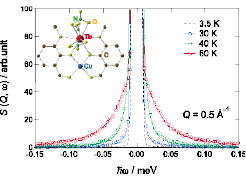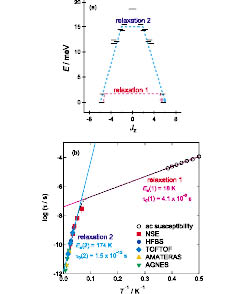Magnetic Relaxation in a Tb-based Single Molecule Magnet
Yamamuro Group
A single-molecule magnet (SMM) is a metal complex that behaves as an individual nanomagnet. Each molecule, containing several metal centers with unpaired electrons, possesses a giant resultant spin. Given that the giant spin exhibits easy-axis anisotropy (D < 0), the magnetization reversal between the ground states with Sz = +/-S is hindered by the potential barrier of DSz2. The traditional research subjects have been SMMs containing multiple transition metal atoms such as Mn, Fe, and Ni, while the current mainstream is shifting to lanthanide SMMs. Owing to a large contribution of angular momentum, lanthanide complexes can become SMMs containing only one or two magnetic ions. One of the central issues in lanthanide SMMs is the quantum tunneling mechanism for the magnetization reversal. In most cases, the tunneling occurs between ground states (pure tunneling process) and/or excited states (thermally assisted tunneling process). The origins of the tunneling have not been fully understood yet.

Fig. 1. Dynamic structure factors of TbCu-SMM. The data at 3.5 K represent the resolution function. The other data are fitted to the combination of delta and Lorentz functions. The inset shows the molecular structure of TbCu-SMM.

Fig. 2. (a) Calculated energy diagram as a function of z-component of the total angular momentum of Tb ion. Dashed lines represent possible relaxation processes. (b) Arrhenius plot of the relaxation times observed on the five spectrometers. The results from the ac susceptibility measurements are also shown.
We have investigated the spin dynamics of Tb-Cu dinuclear SMM by means of neutron scattering techniques. The chemical formula of the sample is TbCuC19D20N3O16 and its molecular structure is schematically shown in the inset of Fig.1. In order to reduce the contribution from the strong incoherent scattering of H atoms, the sample was fully deuterated. Only two magnetic ions, Tb3+(J = 6) and Cu2+(S = 1/2), are involved in a molecule. Following inelastic neutron scattering studies to determine the energy scheme [1], we investigated the magnetic relaxation by means of quasielastic neutron scattering (QENS) experiments using various spectrometers with different energy resolutions; AGNES (∆E = 49 µeV) at JRR-3, AMATERAS (∆E = 120 µeV) at J-PARC, TOFTOF (∆E = 8 µeV) at FRM II (Germany), HFBS (∆E = 0.8 µeV) and neutron spin-echo NSE (Fourier time, 0.007 < t < 12 ns) at NCNR (USA) [2]. The use of five spectrometers enables us to investigate relaxations over a wide time range between 1 ps and 100 ns.
Figure 1 shows the dynamic structure factors of Tb-Cu SMM at Q = 0.5Å-1 taken on the TOFTOF spectrometer. Clearly, QENS broadening was observed above 30 K. The QENS spectra were well fitted to the combination of delta and Lorentz functions. The linewidth of the Lorentzian, Γ(Q), exhibits no pronounced Q-dependence, indicating that the relaxation is of a local origin. The relaxation times were obtained from the relation τ = 1/Γ. In Fig. 2(b), we show the Arrhenius plot of relaxation times estimated from the QENS together with those from the ac magnetic susceptibility measurements. This provides a clear evidence of the existence of two distinct relaxation processes. We designate the slower relaxation as the relaxation 1 and the faster one as relaxation 2. Both relaxation processes follow the Arrhenius relation τ = τ0exp(∆Ea/kBT). As for the relaxation 1, the activation energy Ea and prefactor τ0 are estimated to be 16.0 K and 4.1 × 10-8 s, respectively. It should be emphasized that Ea corresponds to the excitation energy of 1.7 meV observed in the INS study [1]. We have calculated an energy diagram as a function of the z-component of the total angular momentum of the Tb ion, Jz (see Fig. 2(a)), assuming the spin Hamiltonian including ligand field anisotropy, exchange interaction between Tb3+ and Cu2+, and hyperfine interaction. The excitation of 1.7 meV is the transition between the ground and the first excited states. We thus conclude that the magnetization reversal occurs through quantum tunneling between the pairs of degenerated excited states at 1.7 meV. This is called thermally activated tunneling process, in other words the Orbach mechanism of spin-lattice relaxation. On the other hand, the relaxation 2 detected by QENS has quite different Ea and τ0; Ea(2) = 174 K and τ0(2) = 1.5 × 10-12 s. The relaxation 2 is also of the Debye type and gets activated upon heating according to the Arrhenius law. The simplest scenario for the origin of the relaxation 2 is that the relaxation 2 takes place through the tunneling between higher excited states. The activation energy of 174 K (= 15 meV) roughly corresponds to the higher energy level as seen in the energy diagram in Fig. 2(a).
This is the first successful QENS work to observe magnetic relaxation in SMM. The use of QENS can open a new window into the study of relaxation processes in the class of SMMs.
References
- [1] M. Kofu, O. Yamamuro, T. Kajiwara, Y. Yoshimura, M. Nakano, K. Nakajima, S. Ohira-Kawamura, T. Kikuchi, and Y. Inamura, Phys. Rev. B 88, 064405 (2013).
- [2] M. Kofu, T. Kajiwara, J. S. Gardner, G. G. Simeoni, M. Tyagi, A. Faraone, K. Nakajima, S. Ohira-Kawamura, M. Nakano, and O. Yamamuro, Chem. Phys. 427, 147 (2013).
